Managing Across Borders: Outsourcing Strategies in Business Report
VerifiedAdded on 2020/02/19
|17
|4198
|39
Report
AI Summary
This report provides a comprehensive analysis of outsourcing strategies for contemporary business organizations, examining both the advantages and disadvantages. It begins with an introduction to the concept, highlighting the importance of cost reduction and competitive advantage in the current market. The report then critically analyzes outsourcing, defining it as the delegation of business activities to third-party vendors, and explores its benefits, such as cost-effectiveness and access to skilled labor. It also delves into the outsourcing of information technology and manufacturing, and examines the challenges, including managing human resources and maintaining managerial control. Furthermore, the report addresses the impact of the current political environment on outsourcing, particularly in developed countries, and concludes with recommendations for effective implementation of outsourcing strategies. The report emphasizes that outsourcing is a key strategy for contemporary businesses aiming to gain competitive advantages.
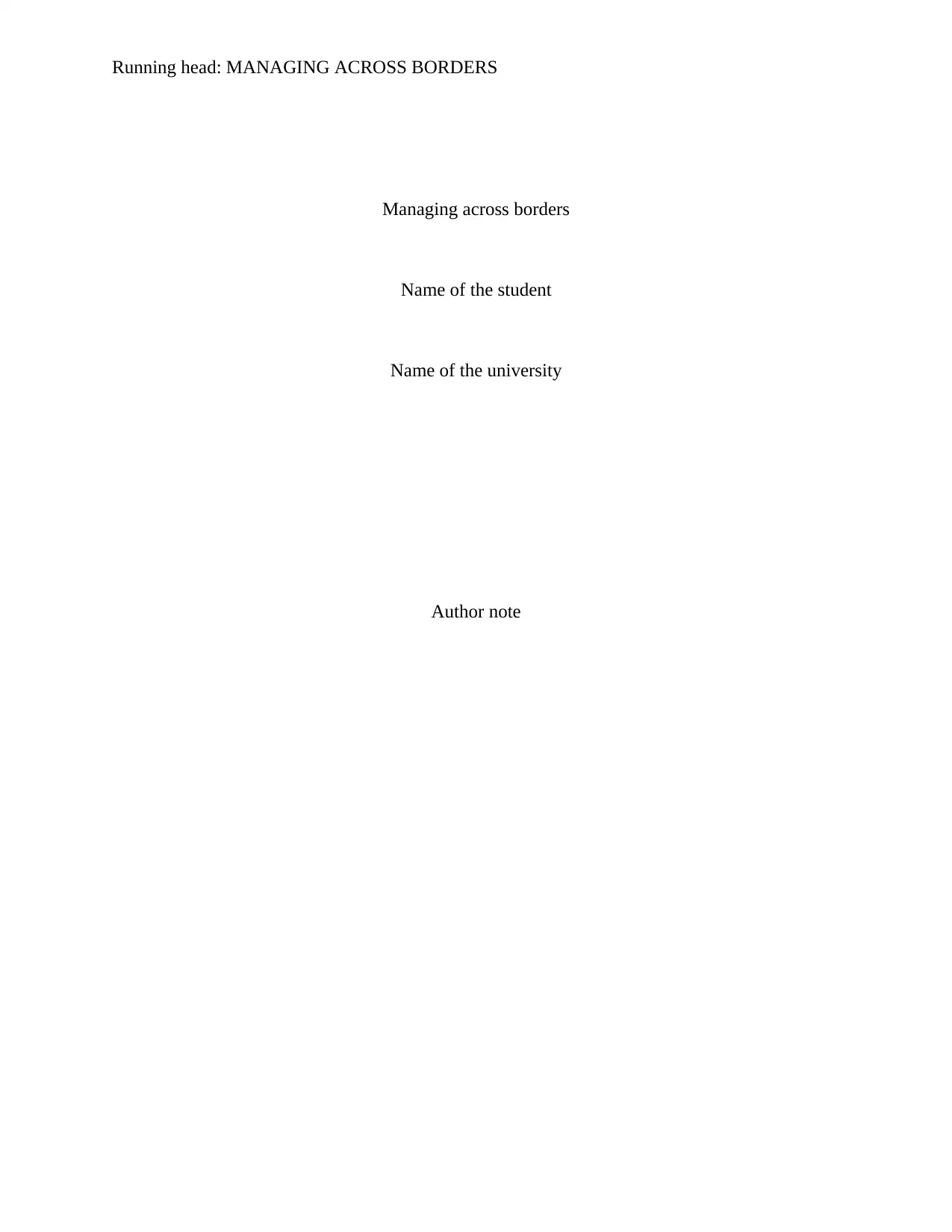
Running head: MANAGING ACROSS BORDERS
Managing across borders
Name of the student
Name of the university
Author note
Managing across borders
Name of the student
Name of the university
Author note
Paraphrase This Document
Need a fresh take? Get an instant paraphrase of this document with our AI Paraphraser
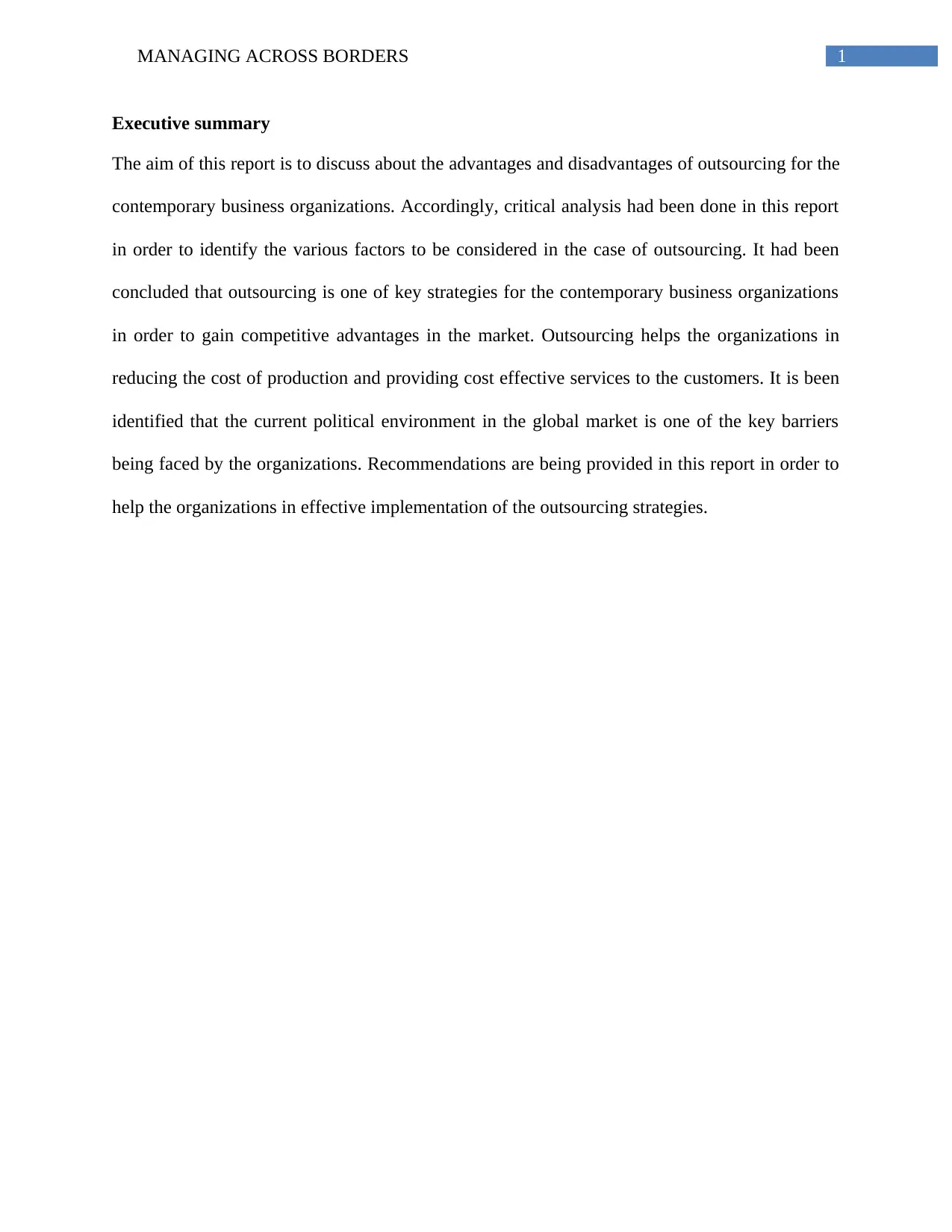
1MANAGING ACROSS BORDERS
Executive summary
The aim of this report is to discuss about the advantages and disadvantages of outsourcing for the
contemporary business organizations. Accordingly, critical analysis had been done in this report
in order to identify the various factors to be considered in the case of outsourcing. It had been
concluded that outsourcing is one of key strategies for the contemporary business organizations
in order to gain competitive advantages in the market. Outsourcing helps the organizations in
reducing the cost of production and providing cost effective services to the customers. It is been
identified that the current political environment in the global market is one of the key barriers
being faced by the organizations. Recommendations are being provided in this report in order to
help the organizations in effective implementation of the outsourcing strategies.
Executive summary
The aim of this report is to discuss about the advantages and disadvantages of outsourcing for the
contemporary business organizations. Accordingly, critical analysis had been done in this report
in order to identify the various factors to be considered in the case of outsourcing. It had been
concluded that outsourcing is one of key strategies for the contemporary business organizations
in order to gain competitive advantages in the market. Outsourcing helps the organizations in
reducing the cost of production and providing cost effective services to the customers. It is been
identified that the current political environment in the global market is one of the key barriers
being faced by the organizations. Recommendations are being provided in this report in order to
help the organizations in effective implementation of the outsourcing strategies.
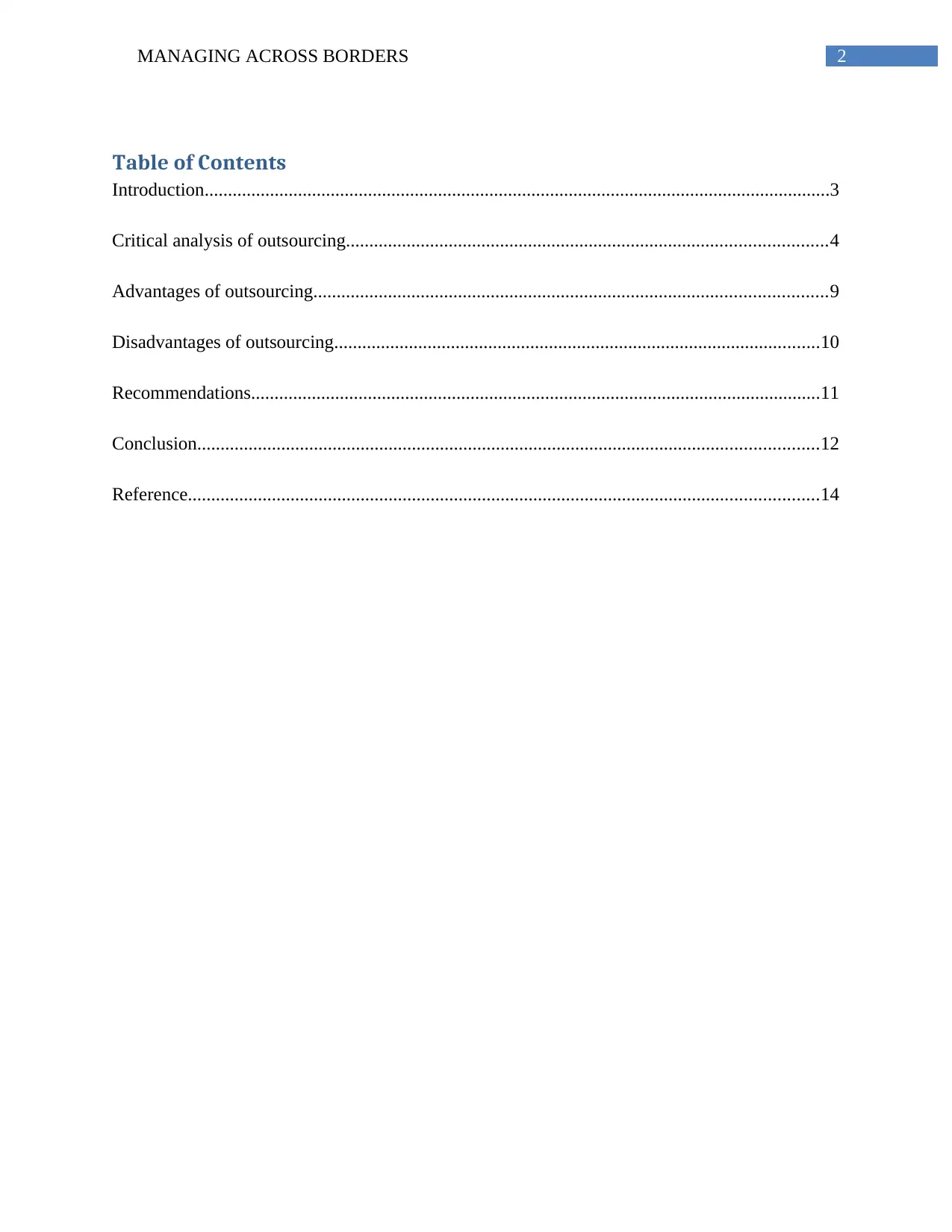
2MANAGING ACROSS BORDERS
Table of Contents
Introduction......................................................................................................................................3
Critical analysis of outsourcing.......................................................................................................4
Advantages of outsourcing..............................................................................................................9
Disadvantages of outsourcing........................................................................................................10
Recommendations..........................................................................................................................11
Conclusion.....................................................................................................................................12
Reference.......................................................................................................................................14
Table of Contents
Introduction......................................................................................................................................3
Critical analysis of outsourcing.......................................................................................................4
Advantages of outsourcing..............................................................................................................9
Disadvantages of outsourcing........................................................................................................10
Recommendations..........................................................................................................................11
Conclusion.....................................................................................................................................12
Reference.......................................................................................................................................14
⊘ This is a preview!⊘
Do you want full access?
Subscribe today to unlock all pages.

Trusted by 1+ million students worldwide
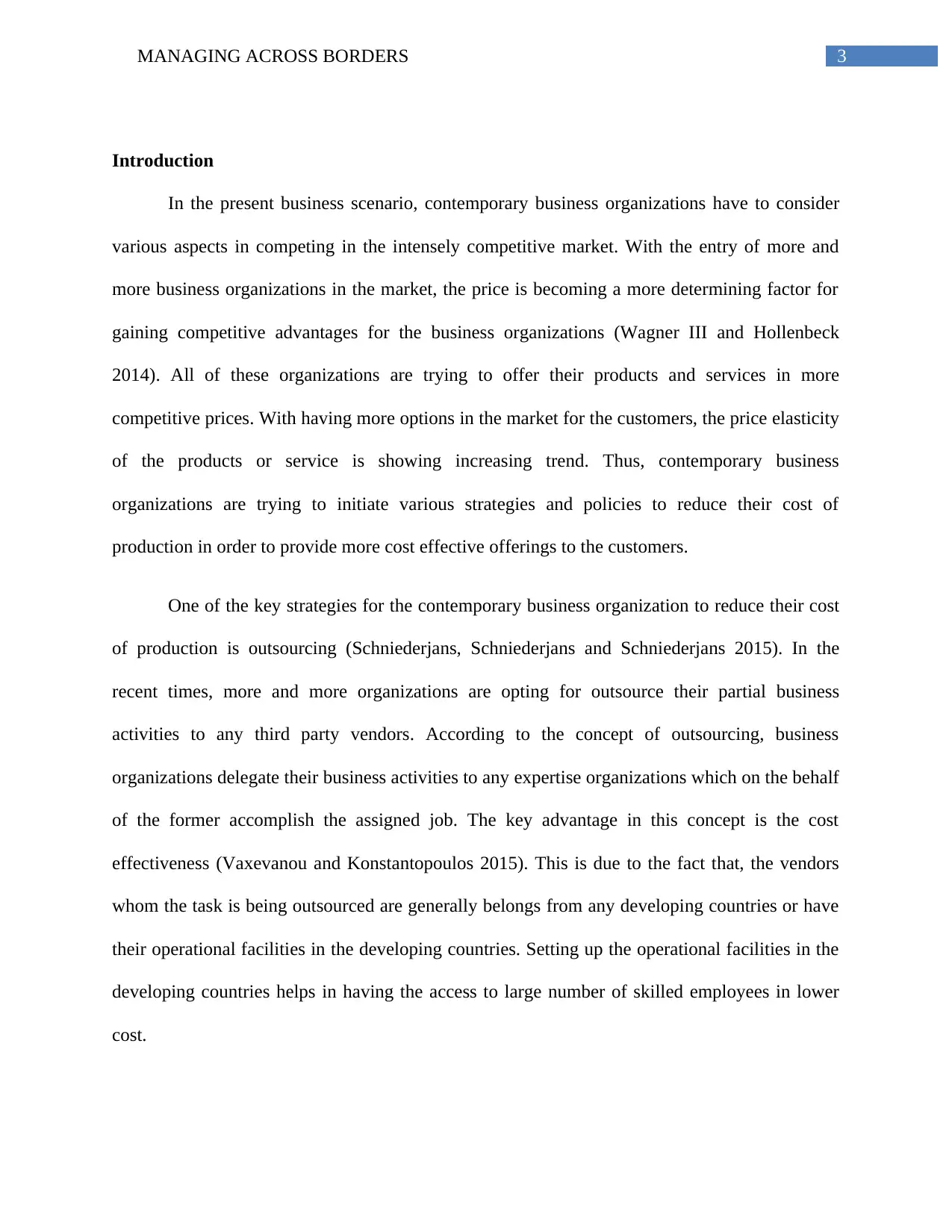
3MANAGING ACROSS BORDERS
Introduction
In the present business scenario, contemporary business organizations have to consider
various aspects in competing in the intensely competitive market. With the entry of more and
more business organizations in the market, the price is becoming a more determining factor for
gaining competitive advantages for the business organizations (Wagner III and Hollenbeck
2014). All of these organizations are trying to offer their products and services in more
competitive prices. With having more options in the market for the customers, the price elasticity
of the products or service is showing increasing trend. Thus, contemporary business
organizations are trying to initiate various strategies and policies to reduce their cost of
production in order to provide more cost effective offerings to the customers.
One of the key strategies for the contemporary business organization to reduce their cost
of production is outsourcing (Schniederjans, Schniederjans and Schniederjans 2015). In the
recent times, more and more organizations are opting for outsource their partial business
activities to any third party vendors. According to the concept of outsourcing, business
organizations delegate their business activities to any expertise organizations which on the behalf
of the former accomplish the assigned job. The key advantage in this concept is the cost
effectiveness (Vaxevanou and Konstantopoulos 2015). This is due to the fact that, the vendors
whom the task is being outsourced are generally belongs from any developing countries or have
their operational facilities in the developing countries. Setting up the operational facilities in the
developing countries helps in having the access to large number of skilled employees in lower
cost.
Introduction
In the present business scenario, contemporary business organizations have to consider
various aspects in competing in the intensely competitive market. With the entry of more and
more business organizations in the market, the price is becoming a more determining factor for
gaining competitive advantages for the business organizations (Wagner III and Hollenbeck
2014). All of these organizations are trying to offer their products and services in more
competitive prices. With having more options in the market for the customers, the price elasticity
of the products or service is showing increasing trend. Thus, contemporary business
organizations are trying to initiate various strategies and policies to reduce their cost of
production in order to provide more cost effective offerings to the customers.
One of the key strategies for the contemporary business organization to reduce their cost
of production is outsourcing (Schniederjans, Schniederjans and Schniederjans 2015). In the
recent times, more and more organizations are opting for outsource their partial business
activities to any third party vendors. According to the concept of outsourcing, business
organizations delegate their business activities to any expertise organizations which on the behalf
of the former accomplish the assigned job. The key advantage in this concept is the cost
effectiveness (Vaxevanou and Konstantopoulos 2015). This is due to the fact that, the vendors
whom the task is being outsourced are generally belongs from any developing countries or have
their operational facilities in the developing countries. Setting up the operational facilities in the
developing countries helps in having the access to large number of skilled employees in lower
cost.
Paraphrase This Document
Need a fresh take? Get an instant paraphrase of this document with our AI Paraphraser
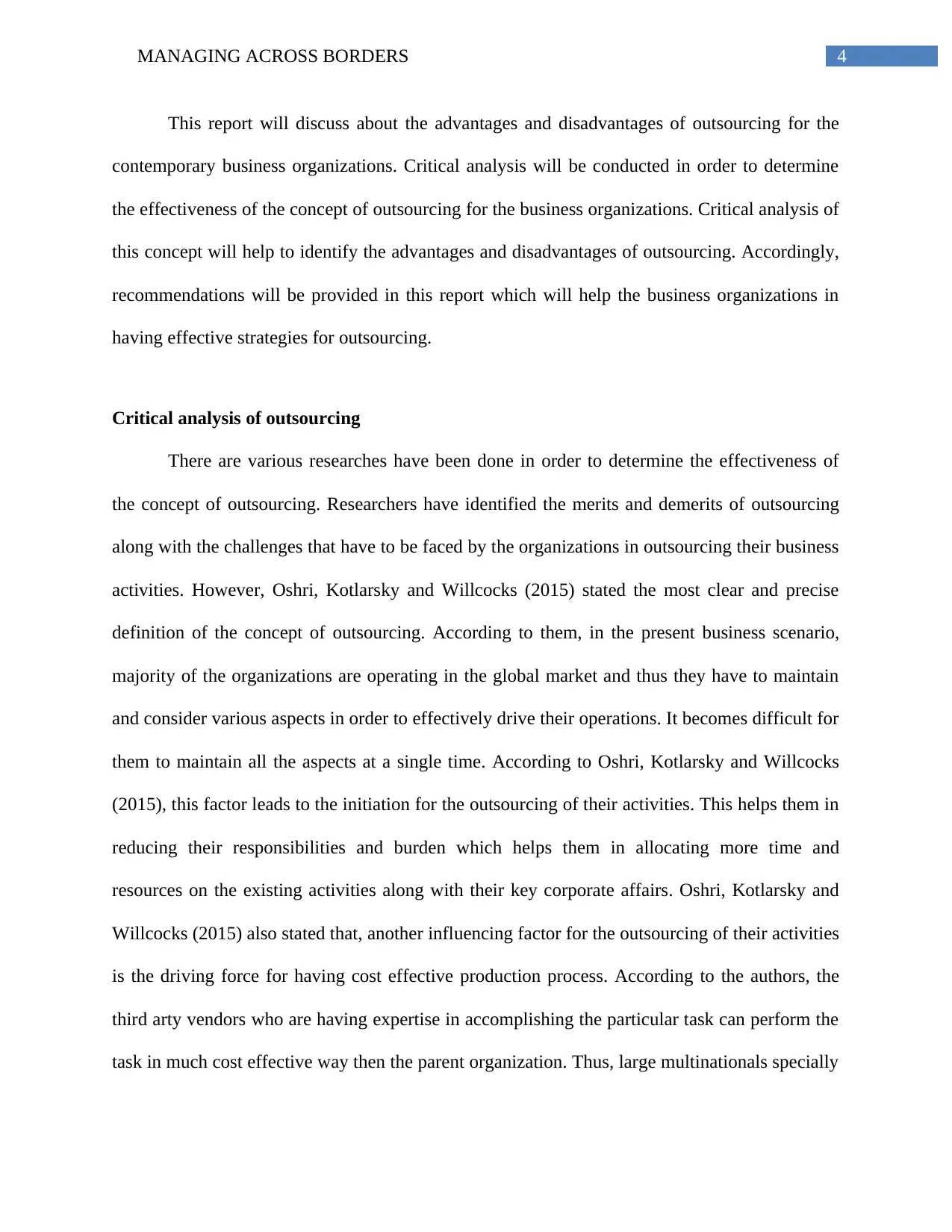
4MANAGING ACROSS BORDERS
This report will discuss about the advantages and disadvantages of outsourcing for the
contemporary business organizations. Critical analysis will be conducted in order to determine
the effectiveness of the concept of outsourcing for the business organizations. Critical analysis of
this concept will help to identify the advantages and disadvantages of outsourcing. Accordingly,
recommendations will be provided in this report which will help the business organizations in
having effective strategies for outsourcing.
Critical analysis of outsourcing
There are various researches have been done in order to determine the effectiveness of
the concept of outsourcing. Researchers have identified the merits and demerits of outsourcing
along with the challenges that have to be faced by the organizations in outsourcing their business
activities. However, Oshri, Kotlarsky and Willcocks (2015) stated the most clear and precise
definition of the concept of outsourcing. According to them, in the present business scenario,
majority of the organizations are operating in the global market and thus they have to maintain
and consider various aspects in order to effectively drive their operations. It becomes difficult for
them to maintain all the aspects at a single time. According to Oshri, Kotlarsky and Willcocks
(2015), this factor leads to the initiation for the outsourcing of their activities. This helps them in
reducing their responsibilities and burden which helps them in allocating more time and
resources on the existing activities along with their key corporate affairs. Oshri, Kotlarsky and
Willcocks (2015) also stated that, another influencing factor for the outsourcing of their activities
is the driving force for having cost effective production process. According to the authors, the
third arty vendors who are having expertise in accomplishing the particular task can perform the
task in much cost effective way then the parent organization. Thus, large multinationals specially
This report will discuss about the advantages and disadvantages of outsourcing for the
contemporary business organizations. Critical analysis will be conducted in order to determine
the effectiveness of the concept of outsourcing for the business organizations. Critical analysis of
this concept will help to identify the advantages and disadvantages of outsourcing. Accordingly,
recommendations will be provided in this report which will help the business organizations in
having effective strategies for outsourcing.
Critical analysis of outsourcing
There are various researches have been done in order to determine the effectiveness of
the concept of outsourcing. Researchers have identified the merits and demerits of outsourcing
along with the challenges that have to be faced by the organizations in outsourcing their business
activities. However, Oshri, Kotlarsky and Willcocks (2015) stated the most clear and precise
definition of the concept of outsourcing. According to them, in the present business scenario,
majority of the organizations are operating in the global market and thus they have to maintain
and consider various aspects in order to effectively drive their operations. It becomes difficult for
them to maintain all the aspects at a single time. According to Oshri, Kotlarsky and Willcocks
(2015), this factor leads to the initiation for the outsourcing of their activities. This helps them in
reducing their responsibilities and burden which helps them in allocating more time and
resources on the existing activities along with their key corporate affairs. Oshri, Kotlarsky and
Willcocks (2015) also stated that, another influencing factor for the outsourcing of their activities
is the driving force for having cost effective production process. According to the authors, the
third arty vendors who are having expertise in accomplishing the particular task can perform the
task in much cost effective way then the parent organization. Thus, large multinationals specially
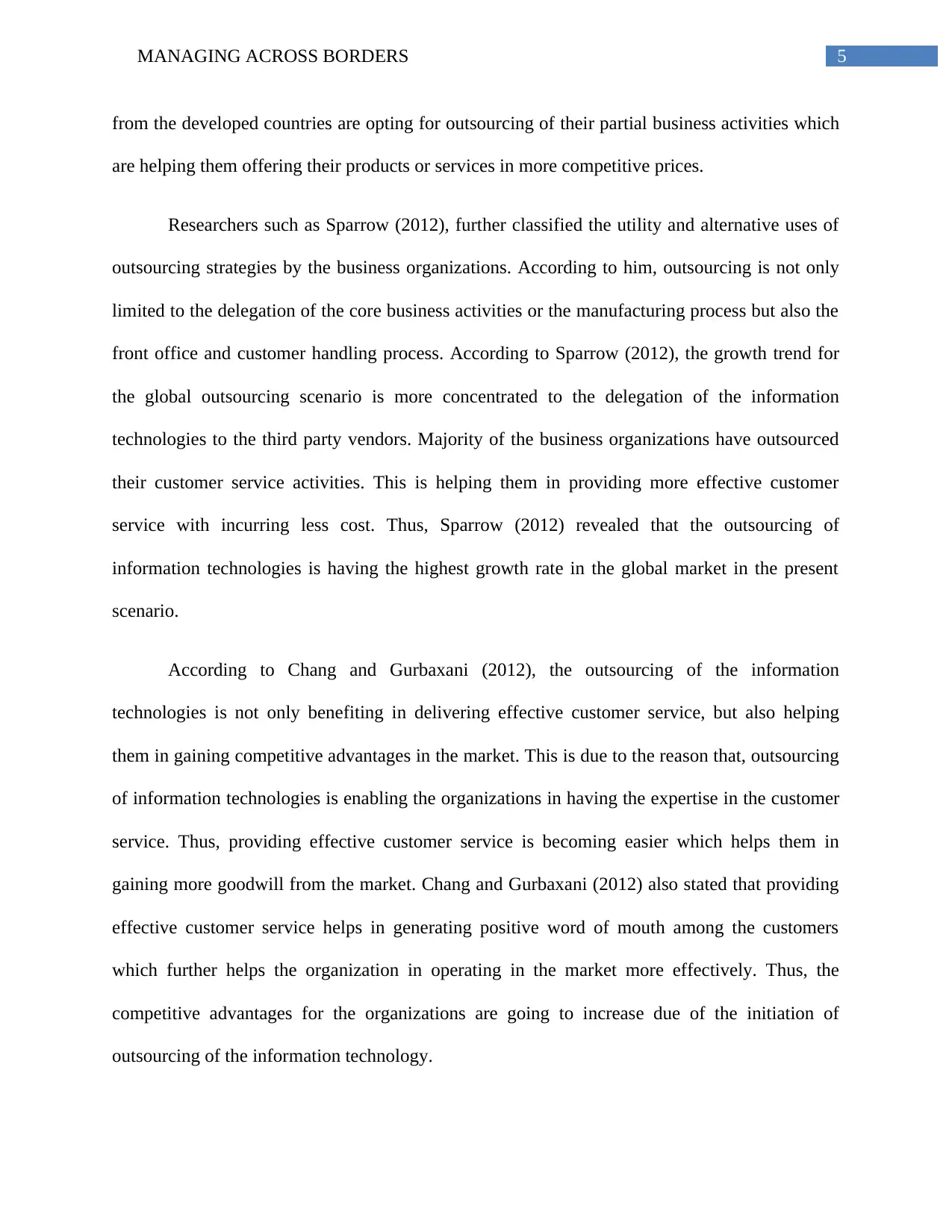
5MANAGING ACROSS BORDERS
from the developed countries are opting for outsourcing of their partial business activities which
are helping them offering their products or services in more competitive prices.
Researchers such as Sparrow (2012), further classified the utility and alternative uses of
outsourcing strategies by the business organizations. According to him, outsourcing is not only
limited to the delegation of the core business activities or the manufacturing process but also the
front office and customer handling process. According to Sparrow (2012), the growth trend for
the global outsourcing scenario is more concentrated to the delegation of the information
technologies to the third party vendors. Majority of the business organizations have outsourced
their customer service activities. This is helping them in providing more effective customer
service with incurring less cost. Thus, Sparrow (2012) revealed that the outsourcing of
information technologies is having the highest growth rate in the global market in the present
scenario.
According to Chang and Gurbaxani (2012), the outsourcing of the information
technologies is not only benefiting in delivering effective customer service, but also helping
them in gaining competitive advantages in the market. This is due to the reason that, outsourcing
of information technologies is enabling the organizations in having the expertise in the customer
service. Thus, providing effective customer service is becoming easier which helps them in
gaining more goodwill from the market. Chang and Gurbaxani (2012) also stated that providing
effective customer service helps in generating positive word of mouth among the customers
which further helps the organization in operating in the market more effectively. Thus, the
competitive advantages for the organizations are going to increase due of the initiation of
outsourcing of the information technology.
from the developed countries are opting for outsourcing of their partial business activities which
are helping them offering their products or services in more competitive prices.
Researchers such as Sparrow (2012), further classified the utility and alternative uses of
outsourcing strategies by the business organizations. According to him, outsourcing is not only
limited to the delegation of the core business activities or the manufacturing process but also the
front office and customer handling process. According to Sparrow (2012), the growth trend for
the global outsourcing scenario is more concentrated to the delegation of the information
technologies to the third party vendors. Majority of the business organizations have outsourced
their customer service activities. This is helping them in providing more effective customer
service with incurring less cost. Thus, Sparrow (2012) revealed that the outsourcing of
information technologies is having the highest growth rate in the global market in the present
scenario.
According to Chang and Gurbaxani (2012), the outsourcing of the information
technologies is not only benefiting in delivering effective customer service, but also helping
them in gaining competitive advantages in the market. This is due to the reason that, outsourcing
of information technologies is enabling the organizations in having the expertise in the customer
service. Thus, providing effective customer service is becoming easier which helps them in
gaining more goodwill from the market. Chang and Gurbaxani (2012) also stated that providing
effective customer service helps in generating positive word of mouth among the customers
which further helps the organization in operating in the market more effectively. Thus, the
competitive advantages for the organizations are going to increase due of the initiation of
outsourcing of the information technology.
⊘ This is a preview!⊘
Do you want full access?
Subscribe today to unlock all pages.

Trusted by 1+ million students worldwide
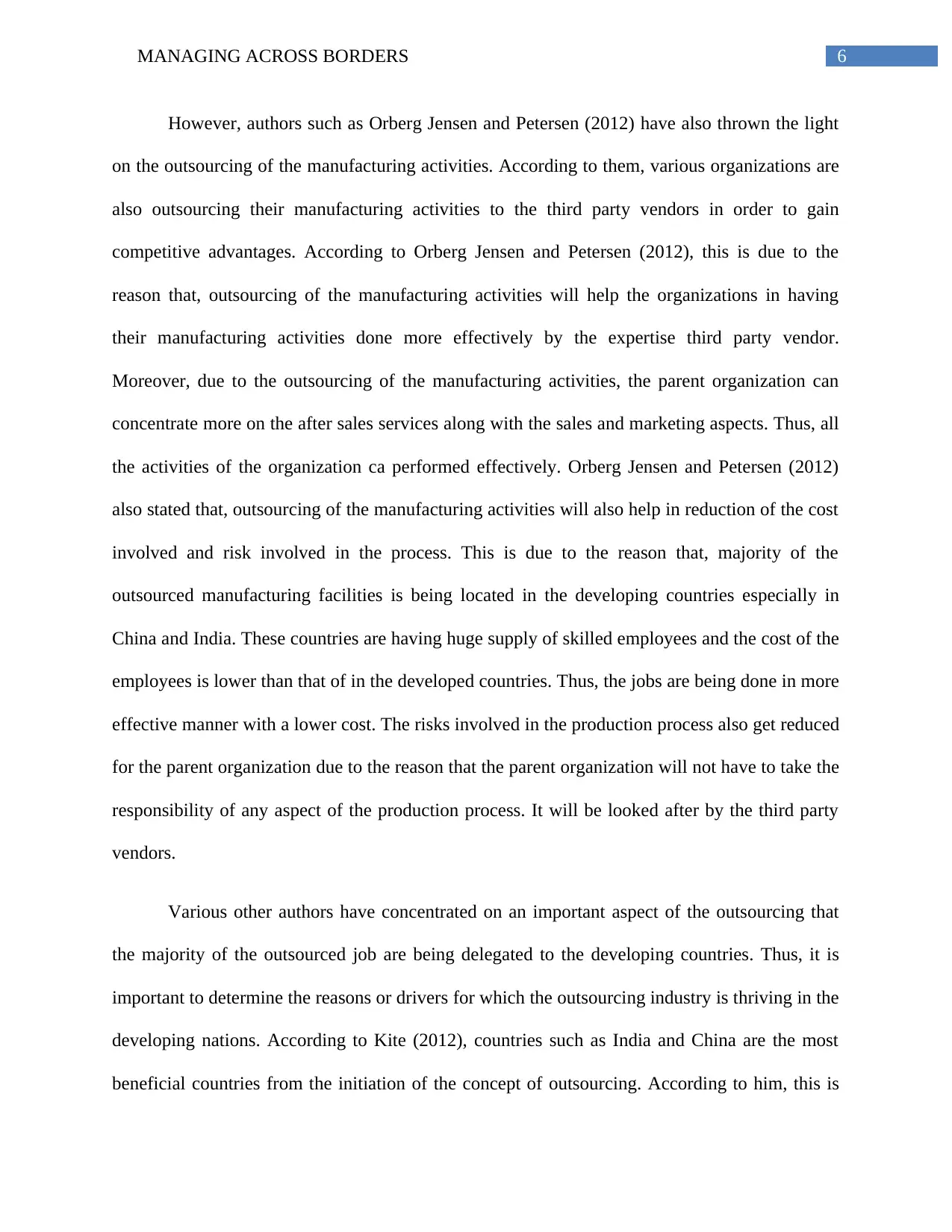
6MANAGING ACROSS BORDERS
However, authors such as Orberg Jensen and Petersen (2012) have also thrown the light
on the outsourcing of the manufacturing activities. According to them, various organizations are
also outsourcing their manufacturing activities to the third party vendors in order to gain
competitive advantages. According to Orberg Jensen and Petersen (2012), this is due to the
reason that, outsourcing of the manufacturing activities will help the organizations in having
their manufacturing activities done more effectively by the expertise third party vendor.
Moreover, due to the outsourcing of the manufacturing activities, the parent organization can
concentrate more on the after sales services along with the sales and marketing aspects. Thus, all
the activities of the organization ca performed effectively. Orberg Jensen and Petersen (2012)
also stated that, outsourcing of the manufacturing activities will also help in reduction of the cost
involved and risk involved in the process. This is due to the reason that, majority of the
outsourced manufacturing facilities is being located in the developing countries especially in
China and India. These countries are having huge supply of skilled employees and the cost of the
employees is lower than that of in the developed countries. Thus, the jobs are being done in more
effective manner with a lower cost. The risks involved in the production process also get reduced
for the parent organization due to the reason that the parent organization will not have to take the
responsibility of any aspect of the production process. It will be looked after by the third party
vendors.
Various other authors have concentrated on an important aspect of the outsourcing that
the majority of the outsourced job are being delegated to the developing countries. Thus, it is
important to determine the reasons or drivers for which the outsourcing industry is thriving in the
developing nations. According to Kite (2012), countries such as India and China are the most
beneficial countries from the initiation of the concept of outsourcing. According to him, this is
However, authors such as Orberg Jensen and Petersen (2012) have also thrown the light
on the outsourcing of the manufacturing activities. According to them, various organizations are
also outsourcing their manufacturing activities to the third party vendors in order to gain
competitive advantages. According to Orberg Jensen and Petersen (2012), this is due to the
reason that, outsourcing of the manufacturing activities will help the organizations in having
their manufacturing activities done more effectively by the expertise third party vendor.
Moreover, due to the outsourcing of the manufacturing activities, the parent organization can
concentrate more on the after sales services along with the sales and marketing aspects. Thus, all
the activities of the organization ca performed effectively. Orberg Jensen and Petersen (2012)
also stated that, outsourcing of the manufacturing activities will also help in reduction of the cost
involved and risk involved in the process. This is due to the reason that, majority of the
outsourced manufacturing facilities is being located in the developing countries especially in
China and India. These countries are having huge supply of skilled employees and the cost of the
employees is lower than that of in the developed countries. Thus, the jobs are being done in more
effective manner with a lower cost. The risks involved in the production process also get reduced
for the parent organization due to the reason that the parent organization will not have to take the
responsibility of any aspect of the production process. It will be looked after by the third party
vendors.
Various other authors have concentrated on an important aspect of the outsourcing that
the majority of the outsourced job are being delegated to the developing countries. Thus, it is
important to determine the reasons or drivers for which the outsourcing industry is thriving in the
developing nations. According to Kite (2012), countries such as India and China are the most
beneficial countries from the initiation of the concept of outsourcing. According to him, this is
Paraphrase This Document
Need a fresh take? Get an instant paraphrase of this document with our AI Paraphraser
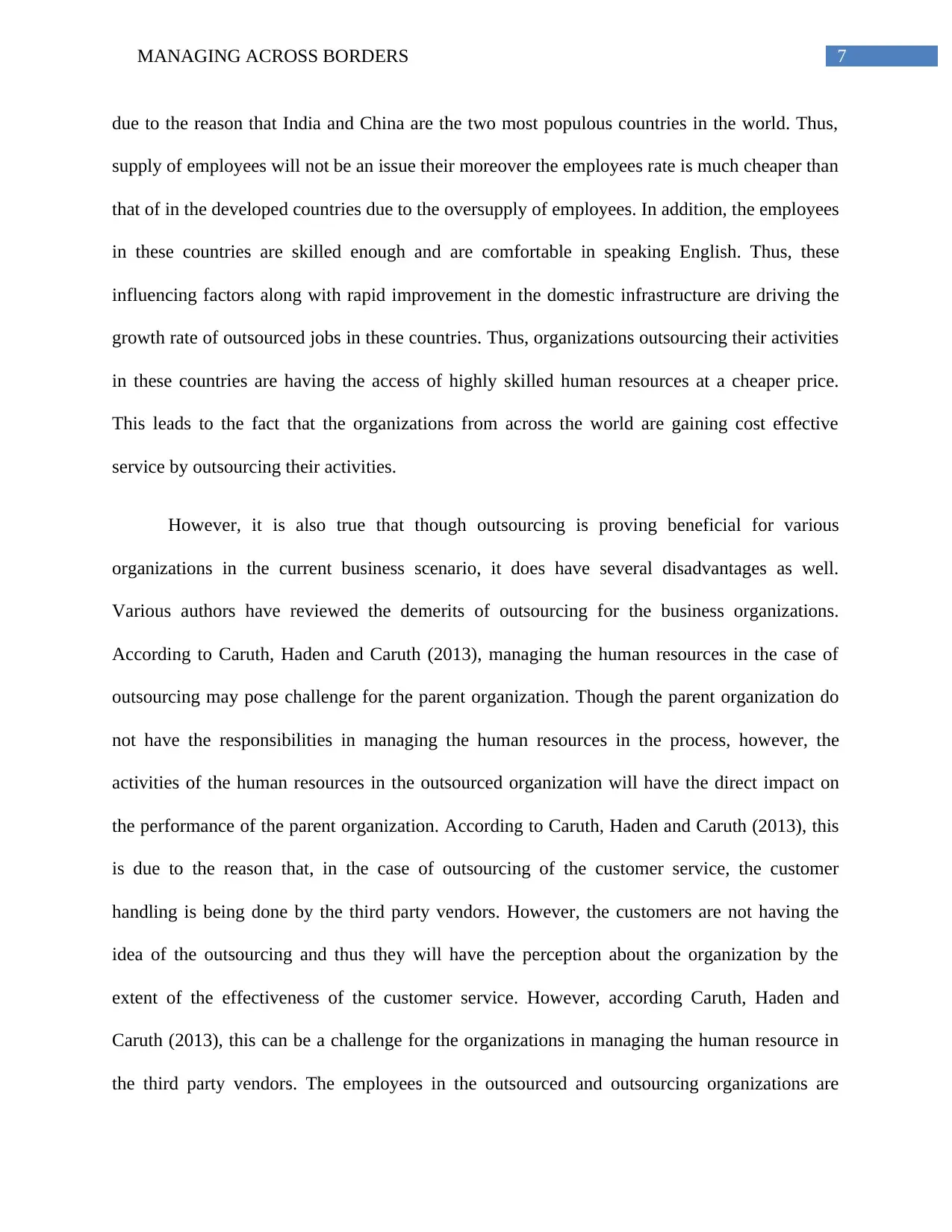
7MANAGING ACROSS BORDERS
due to the reason that India and China are the two most populous countries in the world. Thus,
supply of employees will not be an issue their moreover the employees rate is much cheaper than
that of in the developed countries due to the oversupply of employees. In addition, the employees
in these countries are skilled enough and are comfortable in speaking English. Thus, these
influencing factors along with rapid improvement in the domestic infrastructure are driving the
growth rate of outsourced jobs in these countries. Thus, organizations outsourcing their activities
in these countries are having the access of highly skilled human resources at a cheaper price.
This leads to the fact that the organizations from across the world are gaining cost effective
service by outsourcing their activities.
However, it is also true that though outsourcing is proving beneficial for various
organizations in the current business scenario, it does have several disadvantages as well.
Various authors have reviewed the demerits of outsourcing for the business organizations.
According to Caruth, Haden and Caruth (2013), managing the human resources in the case of
outsourcing may pose challenge for the parent organization. Though the parent organization do
not have the responsibilities in managing the human resources in the process, however, the
activities of the human resources in the outsourced organization will have the direct impact on
the performance of the parent organization. According to Caruth, Haden and Caruth (2013), this
is due to the reason that, in the case of outsourcing of the customer service, the customer
handling is being done by the third party vendors. However, the customers are not having the
idea of the outsourcing and thus they will have the perception about the organization by the
extent of the effectiveness of the customer service. However, according Caruth, Haden and
Caruth (2013), this can be a challenge for the organizations in managing the human resource in
the third party vendors. The employees in the outsourced and outsourcing organizations are
due to the reason that India and China are the two most populous countries in the world. Thus,
supply of employees will not be an issue their moreover the employees rate is much cheaper than
that of in the developed countries due to the oversupply of employees. In addition, the employees
in these countries are skilled enough and are comfortable in speaking English. Thus, these
influencing factors along with rapid improvement in the domestic infrastructure are driving the
growth rate of outsourced jobs in these countries. Thus, organizations outsourcing their activities
in these countries are having the access of highly skilled human resources at a cheaper price.
This leads to the fact that the organizations from across the world are gaining cost effective
service by outsourcing their activities.
However, it is also true that though outsourcing is proving beneficial for various
organizations in the current business scenario, it does have several disadvantages as well.
Various authors have reviewed the demerits of outsourcing for the business organizations.
According to Caruth, Haden and Caruth (2013), managing the human resources in the case of
outsourcing may pose challenge for the parent organization. Though the parent organization do
not have the responsibilities in managing the human resources in the process, however, the
activities of the human resources in the outsourced organization will have the direct impact on
the performance of the parent organization. According to Caruth, Haden and Caruth (2013), this
is due to the reason that, in the case of outsourcing of the customer service, the customer
handling is being done by the third party vendors. However, the customers are not having the
idea of the outsourcing and thus they will have the perception about the organization by the
extent of the effectiveness of the customer service. However, according Caruth, Haden and
Caruth (2013), this can be a challenge for the organizations in managing the human resource in
the third party vendors. The employees in the outsourced and outsourcing organizations are
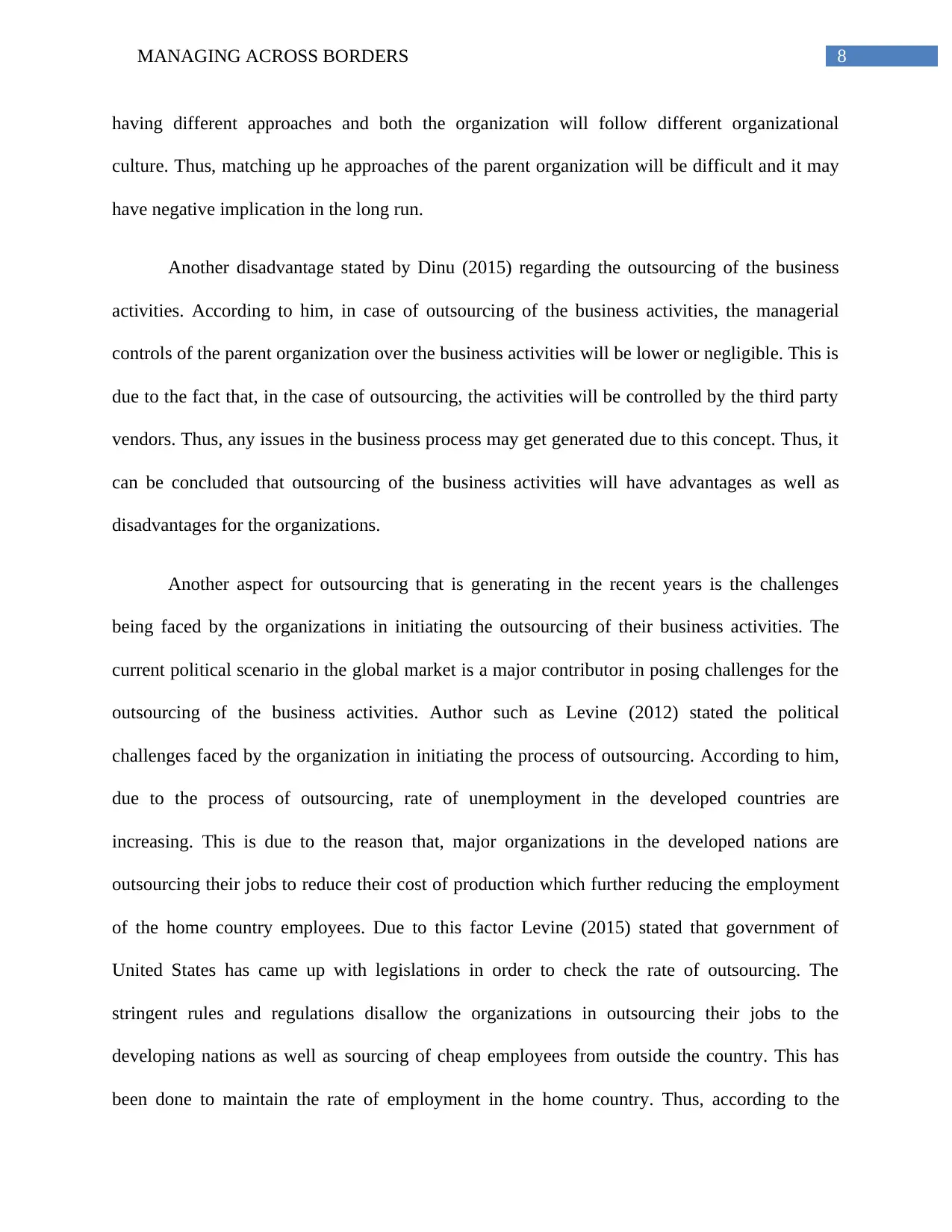
8MANAGING ACROSS BORDERS
having different approaches and both the organization will follow different organizational
culture. Thus, matching up he approaches of the parent organization will be difficult and it may
have negative implication in the long run.
Another disadvantage stated by Dinu (2015) regarding the outsourcing of the business
activities. According to him, in case of outsourcing of the business activities, the managerial
controls of the parent organization over the business activities will be lower or negligible. This is
due to the fact that, in the case of outsourcing, the activities will be controlled by the third party
vendors. Thus, any issues in the business process may get generated due to this concept. Thus, it
can be concluded that outsourcing of the business activities will have advantages as well as
disadvantages for the organizations.
Another aspect for outsourcing that is generating in the recent years is the challenges
being faced by the organizations in initiating the outsourcing of their business activities. The
current political scenario in the global market is a major contributor in posing challenges for the
outsourcing of the business activities. Author such as Levine (2012) stated the political
challenges faced by the organization in initiating the process of outsourcing. According to him,
due to the process of outsourcing, rate of unemployment in the developed countries are
increasing. This is due to the reason that, major organizations in the developed nations are
outsourcing their jobs to reduce their cost of production which further reducing the employment
of the home country employees. Due to this factor Levine (2015) stated that government of
United States has came up with legislations in order to check the rate of outsourcing. The
stringent rules and regulations disallow the organizations in outsourcing their jobs to the
developing nations as well as sourcing of cheap employees from outside the country. This has
been done to maintain the rate of employment in the home country. Thus, according to the
having different approaches and both the organization will follow different organizational
culture. Thus, matching up he approaches of the parent organization will be difficult and it may
have negative implication in the long run.
Another disadvantage stated by Dinu (2015) regarding the outsourcing of the business
activities. According to him, in case of outsourcing of the business activities, the managerial
controls of the parent organization over the business activities will be lower or negligible. This is
due to the fact that, in the case of outsourcing, the activities will be controlled by the third party
vendors. Thus, any issues in the business process may get generated due to this concept. Thus, it
can be concluded that outsourcing of the business activities will have advantages as well as
disadvantages for the organizations.
Another aspect for outsourcing that is generating in the recent years is the challenges
being faced by the organizations in initiating the outsourcing of their business activities. The
current political scenario in the global market is a major contributor in posing challenges for the
outsourcing of the business activities. Author such as Levine (2012) stated the political
challenges faced by the organization in initiating the process of outsourcing. According to him,
due to the process of outsourcing, rate of unemployment in the developed countries are
increasing. This is due to the reason that, major organizations in the developed nations are
outsourcing their jobs to reduce their cost of production which further reducing the employment
of the home country employees. Due to this factor Levine (2015) stated that government of
United States has came up with legislations in order to check the rate of outsourcing. The
stringent rules and regulations disallow the organizations in outsourcing their jobs to the
developing nations as well as sourcing of cheap employees from outside the country. This has
been done to maintain the rate of employment in the home country. Thus, according to the
⊘ This is a preview!⊘
Do you want full access?
Subscribe today to unlock all pages.

Trusted by 1+ million students worldwide
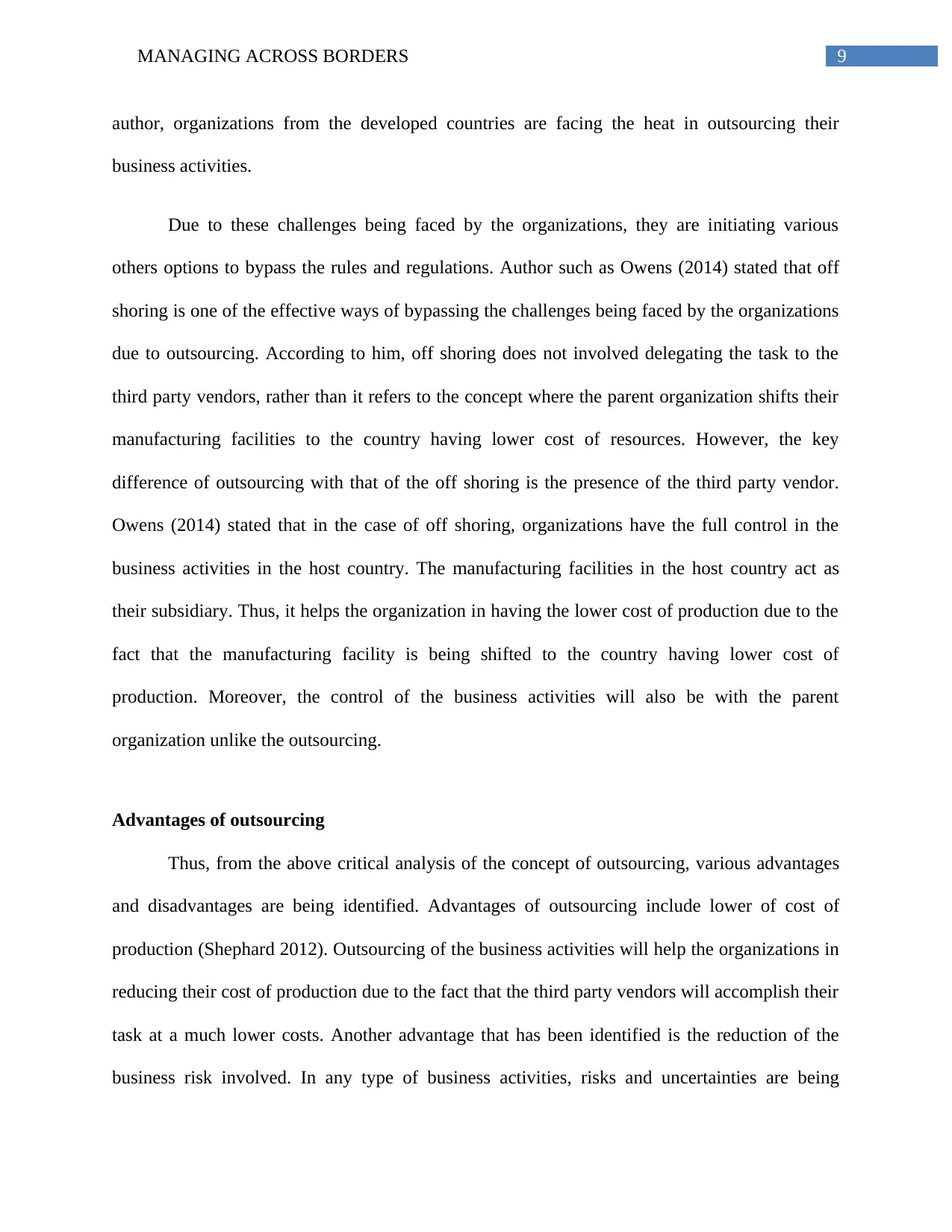
9MANAGING ACROSS BORDERS
author, organizations from the developed countries are facing the heat in outsourcing their
business activities.
Due to these challenges being faced by the organizations, they are initiating various
others options to bypass the rules and regulations. Author such as Owens (2014) stated that off
shoring is one of the effective ways of bypassing the challenges being faced by the organizations
due to outsourcing. According to him, off shoring does not involved delegating the task to the
third party vendors, rather than it refers to the concept where the parent organization shifts their
manufacturing facilities to the country having lower cost of resources. However, the key
difference of outsourcing with that of the off shoring is the presence of the third party vendor.
Owens (2014) stated that in the case of off shoring, organizations have the full control in the
business activities in the host country. The manufacturing facilities in the host country act as
their subsidiary. Thus, it helps the organization in having the lower cost of production due to the
fact that the manufacturing facility is being shifted to the country having lower cost of
production. Moreover, the control of the business activities will also be with the parent
organization unlike the outsourcing.
Advantages of outsourcing
Thus, from the above critical analysis of the concept of outsourcing, various advantages
and disadvantages are being identified. Advantages of outsourcing include lower of cost of
production (Shephard 2012). Outsourcing of the business activities will help the organizations in
reducing their cost of production due to the fact that the third party vendors will accomplish their
task at a much lower costs. Another advantage that has been identified is the reduction of the
business risk involved. In any type of business activities, risks and uncertainties are being
author, organizations from the developed countries are facing the heat in outsourcing their
business activities.
Due to these challenges being faced by the organizations, they are initiating various
others options to bypass the rules and regulations. Author such as Owens (2014) stated that off
shoring is one of the effective ways of bypassing the challenges being faced by the organizations
due to outsourcing. According to him, off shoring does not involved delegating the task to the
third party vendors, rather than it refers to the concept where the parent organization shifts their
manufacturing facilities to the country having lower cost of resources. However, the key
difference of outsourcing with that of the off shoring is the presence of the third party vendor.
Owens (2014) stated that in the case of off shoring, organizations have the full control in the
business activities in the host country. The manufacturing facilities in the host country act as
their subsidiary. Thus, it helps the organization in having the lower cost of production due to the
fact that the manufacturing facility is being shifted to the country having lower cost of
production. Moreover, the control of the business activities will also be with the parent
organization unlike the outsourcing.
Advantages of outsourcing
Thus, from the above critical analysis of the concept of outsourcing, various advantages
and disadvantages are being identified. Advantages of outsourcing include lower of cost of
production (Shephard 2012). Outsourcing of the business activities will help the organizations in
reducing their cost of production due to the fact that the third party vendors will accomplish their
task at a much lower costs. Another advantage that has been identified is the reduction of the
business risk involved. In any type of business activities, risks and uncertainties are being
Paraphrase This Document
Need a fresh take? Get an instant paraphrase of this document with our AI Paraphraser
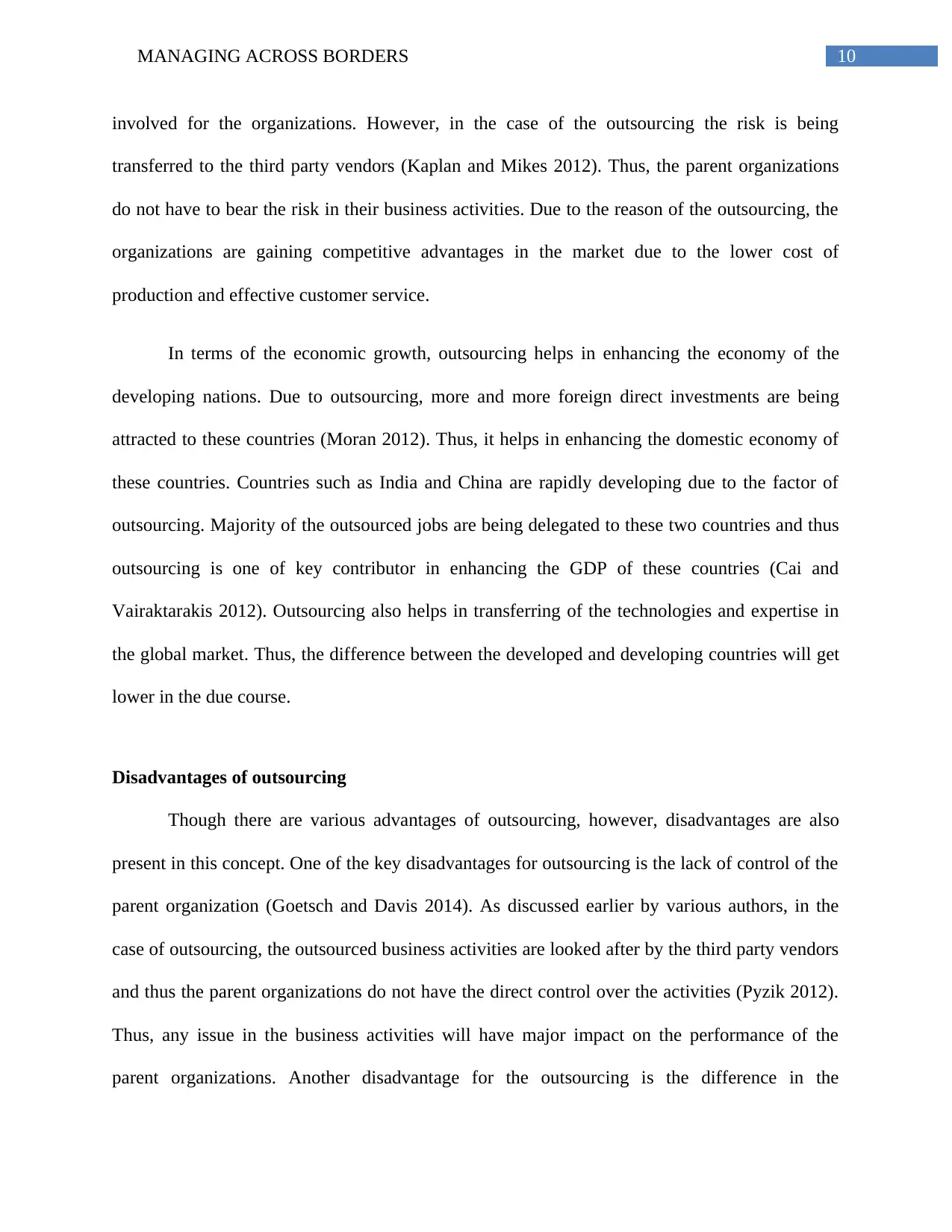
10MANAGING ACROSS BORDERS
involved for the organizations. However, in the case of the outsourcing the risk is being
transferred to the third party vendors (Kaplan and Mikes 2012). Thus, the parent organizations
do not have to bear the risk in their business activities. Due to the reason of the outsourcing, the
organizations are gaining competitive advantages in the market due to the lower cost of
production and effective customer service.
In terms of the economic growth, outsourcing helps in enhancing the economy of the
developing nations. Due to outsourcing, more and more foreign direct investments are being
attracted to these countries (Moran 2012). Thus, it helps in enhancing the domestic economy of
these countries. Countries such as India and China are rapidly developing due to the factor of
outsourcing. Majority of the outsourced jobs are being delegated to these two countries and thus
outsourcing is one of key contributor in enhancing the GDP of these countries (Cai and
Vairaktarakis 2012). Outsourcing also helps in transferring of the technologies and expertise in
the global market. Thus, the difference between the developed and developing countries will get
lower in the due course.
Disadvantages of outsourcing
Though there are various advantages of outsourcing, however, disadvantages are also
present in this concept. One of the key disadvantages for outsourcing is the lack of control of the
parent organization (Goetsch and Davis 2014). As discussed earlier by various authors, in the
case of outsourcing, the outsourced business activities are looked after by the third party vendors
and thus the parent organizations do not have the direct control over the activities (Pyzik 2012).
Thus, any issue in the business activities will have major impact on the performance of the
parent organizations. Another disadvantage for the outsourcing is the difference in the
involved for the organizations. However, in the case of the outsourcing the risk is being
transferred to the third party vendors (Kaplan and Mikes 2012). Thus, the parent organizations
do not have to bear the risk in their business activities. Due to the reason of the outsourcing, the
organizations are gaining competitive advantages in the market due to the lower cost of
production and effective customer service.
In terms of the economic growth, outsourcing helps in enhancing the economy of the
developing nations. Due to outsourcing, more and more foreign direct investments are being
attracted to these countries (Moran 2012). Thus, it helps in enhancing the domestic economy of
these countries. Countries such as India and China are rapidly developing due to the factor of
outsourcing. Majority of the outsourced jobs are being delegated to these two countries and thus
outsourcing is one of key contributor in enhancing the GDP of these countries (Cai and
Vairaktarakis 2012). Outsourcing also helps in transferring of the technologies and expertise in
the global market. Thus, the difference between the developed and developing countries will get
lower in the due course.
Disadvantages of outsourcing
Though there are various advantages of outsourcing, however, disadvantages are also
present in this concept. One of the key disadvantages for outsourcing is the lack of control of the
parent organization (Goetsch and Davis 2014). As discussed earlier by various authors, in the
case of outsourcing, the outsourced business activities are looked after by the third party vendors
and thus the parent organizations do not have the direct control over the activities (Pyzik 2012).
Thus, any issue in the business activities will have major impact on the performance of the
parent organizations. Another disadvantage for the outsourcing is the difference in the
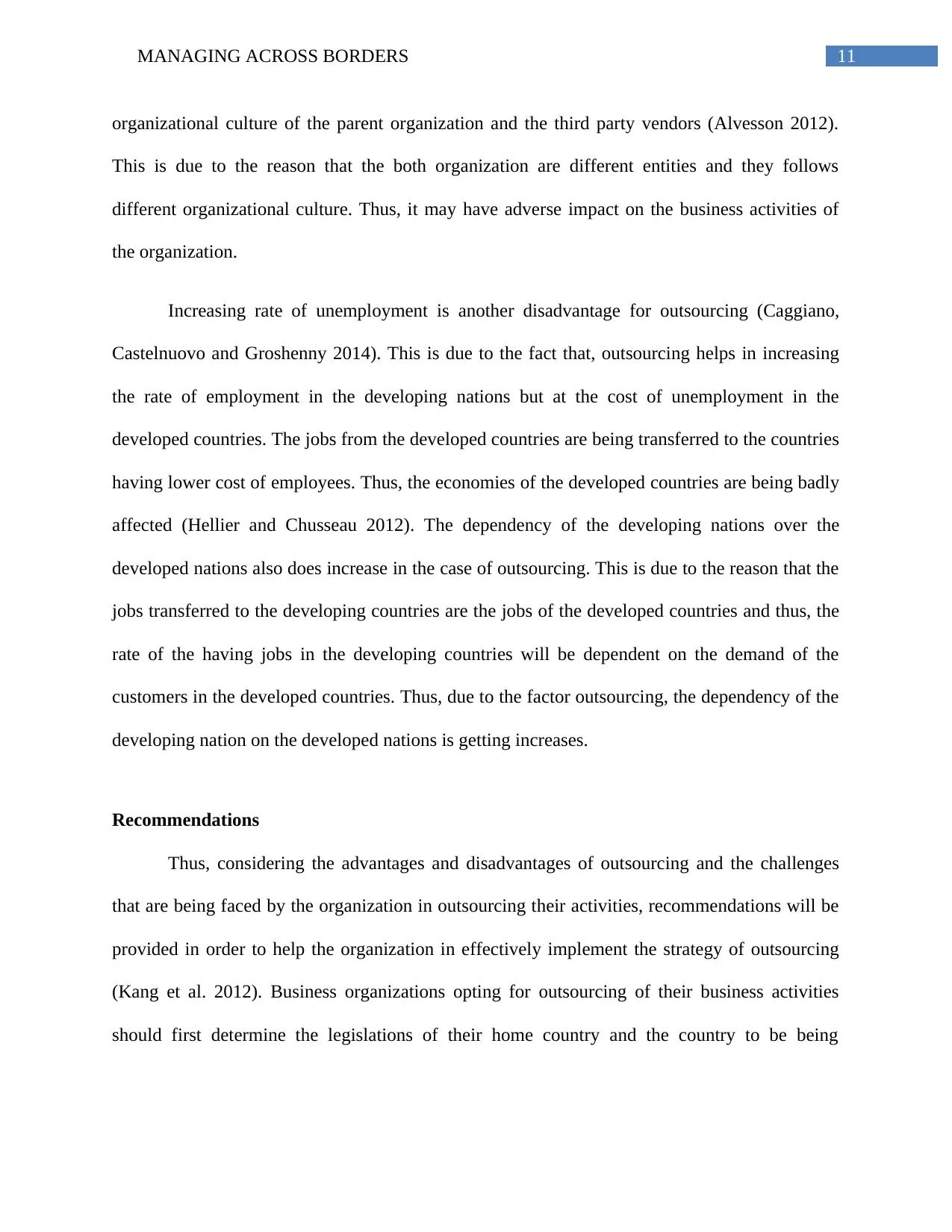
11MANAGING ACROSS BORDERS
organizational culture of the parent organization and the third party vendors (Alvesson 2012).
This is due to the reason that the both organization are different entities and they follows
different organizational culture. Thus, it may have adverse impact on the business activities of
the organization.
Increasing rate of unemployment is another disadvantage for outsourcing (Caggiano,
Castelnuovo and Groshenny 2014). This is due to the fact that, outsourcing helps in increasing
the rate of employment in the developing nations but at the cost of unemployment in the
developed countries. The jobs from the developed countries are being transferred to the countries
having lower cost of employees. Thus, the economies of the developed countries are being badly
affected (Hellier and Chusseau 2012). The dependency of the developing nations over the
developed nations also does increase in the case of outsourcing. This is due to the reason that the
jobs transferred to the developing countries are the jobs of the developed countries and thus, the
rate of the having jobs in the developing countries will be dependent on the demand of the
customers in the developed countries. Thus, due to the factor outsourcing, the dependency of the
developing nation on the developed nations is getting increases.
Recommendations
Thus, considering the advantages and disadvantages of outsourcing and the challenges
that are being faced by the organization in outsourcing their activities, recommendations will be
provided in order to help the organization in effectively implement the strategy of outsourcing
(Kang et al. 2012). Business organizations opting for outsourcing of their business activities
should first determine the legislations of their home country and the country to be being
organizational culture of the parent organization and the third party vendors (Alvesson 2012).
This is due to the reason that the both organization are different entities and they follows
different organizational culture. Thus, it may have adverse impact on the business activities of
the organization.
Increasing rate of unemployment is another disadvantage for outsourcing (Caggiano,
Castelnuovo and Groshenny 2014). This is due to the fact that, outsourcing helps in increasing
the rate of employment in the developing nations but at the cost of unemployment in the
developed countries. The jobs from the developed countries are being transferred to the countries
having lower cost of employees. Thus, the economies of the developed countries are being badly
affected (Hellier and Chusseau 2012). The dependency of the developing nations over the
developed nations also does increase in the case of outsourcing. This is due to the reason that the
jobs transferred to the developing countries are the jobs of the developed countries and thus, the
rate of the having jobs in the developing countries will be dependent on the demand of the
customers in the developed countries. Thus, due to the factor outsourcing, the dependency of the
developing nation on the developed nations is getting increases.
Recommendations
Thus, considering the advantages and disadvantages of outsourcing and the challenges
that are being faced by the organization in outsourcing their activities, recommendations will be
provided in order to help the organization in effectively implement the strategy of outsourcing
(Kang et al. 2012). Business organizations opting for outsourcing of their business activities
should first determine the legislations of their home country and the country to be being
⊘ This is a preview!⊘
Do you want full access?
Subscribe today to unlock all pages.

Trusted by 1+ million students worldwide
1 out of 17
Related Documents
Your All-in-One AI-Powered Toolkit for Academic Success.
+13062052269
info@desklib.com
Available 24*7 on WhatsApp / Email
![[object Object]](/_next/static/media/star-bottom.7253800d.svg)
Unlock your academic potential
Copyright © 2020–2025 A2Z Services. All Rights Reserved. Developed and managed by ZUCOL.





